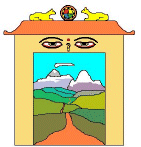
|
The Namche Conference: May 24-26,
2003 Participants and Presentations:
Mr. Ghazi Alam |
|
Mr. Ghazi Alam (Islamabad, Pakistan) Member, Hagler Bailly Pakistan; email: galam@haglerbailly.com.pk Abstract Community Participation and Conservation of the Deosai Plains, Nothern Areas, Pakistan The Deosai is a plateau 20 km wide and 30 km long, situated about 30 km south of Skardu and 80 km east of the Nanga Parbat Range in Pakistan. The elevation ranges from 3 500 to 4 500 m above sea level and falls in the alpine ecological zone. Maximum mean temperature is 8.1 °C to 12 °C, and the minimum mean temperature is -16°C to -20°C. The annual precipitation in Deosai is 510 mm to 750 mm. The Deosai Plateau is situated between two of the major mountain ranges of the world, the Karakoram and Himalayas. It is a center of unique biodiversity as it host plants and animals from Karakoram, Himalayas and Indus Valley. The documented biodiversity includes 342 plant species, 18 mammals, 208 birds, 3 fishes, 1 amphibian and two reptiles. The Deosai plains remain under snow cover during winter months between November to May. Most of the flora has a brief lifecycle. The flora of Deosai is influenced by four major floristic elements: Boreoalpine & Circumpolar; the Euro-Siberian; Southern European/Mediterranean and Siberian-Mongolian. Deosai is internationally recognized as being the only refuge of threatened Himalayan Brown Bears (Ursus arctos isabellinus) in Pakistan. It is the only habitat, where the bear population can still be stabilized and subsequently increased. Deosai was declared a national park in 1994 with primary objective of stabilizing the population of brown bears. This effort has now expanded to protect the entire ecosystem in Deosai. Many communities/villages border the area of the national park. Monitoring over a period of ten years has indicated that despite various natural and anthropogenic threats, the population of bears in Deosai is stable and growing. Major threats to the biodiversity of Deosai area are human encroachment, increasing livestock grazing pressure, hunting, exploitation of plants for economic or medicinal value, bear baiting, bear displays, trade of bear parts and tourism etc. The measures that would help in the conservation and rehabilitation of Deosai's biodiversity include mitigation of root causes of decline like hunting and habitat degradation, reduction in grazing pressure, education and awareness, and long-term ecological research and monitoring program for understanding of Deosai ecology. All of this requires the cooperation and participation of the communities that live in and around the Deosai. Key Words: Deosai, Brown Bears, Himlayas, Communities
|
Email: info@namche.net
